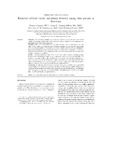| dc.description.abstract | Objective: We investigated whether food variety and diversity are associated with physical and
cognitive functioning in older adults in Botswana and designed a simple set of screening questions
that predict food variety in this population.
Methods: Data were collected (1998) as a national household survey of 1085 subjects 60 y and
older. A food variety score, based on a food frequency checklist, was calculated by summing the
frequency of weekly intakes of 16 food items (0 to 66). A dietary diversity score was calculated as
the number of food groups consumed weekly (0 to 5). A representative subsample (n = 393) was
randomly selected for the clinical component of the survey, and measurements on dependency and
cognitive function were conducted.
Results: Low food variety was found: 35.2%, 59.3%, and 22.4% of subjects consumed no dairy
products, fruits, and vegetables, respectively. A higher food variety score was associated with urban
residence, ownership of cattle, higher education, and more frequent meals, and these indicators were
used to construct a nutritional risk indicator. Higher food variety score was associated with better
self-reported health and better cognitive function. Similarly, a higher score on the nutritional risk
indicator screening tool was associated with desirable health outcomes.
Conclusion: A limited number of foods is consumed, leading to an overall pattern of poor food
variety. Higher food variety was associated with improved physical and cognitive functions. A
screening tool that predicts food variety in this population has been developed and is recommended
to be incorporated at a primary care level to identify older adults most at risk of a poor quality
diet. | en |

